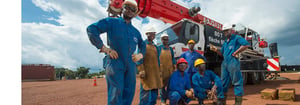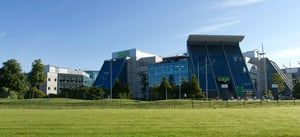Path Investments plc (LON:PATH), the energy and natural resources investment company, has today announced that it has entered into an Asset Purchase Agreement with Zoetic International plc (LON:ZOE), to acquire its 75% ownership of its patented proprietary technology, DT Ultravert, which involves a method for hydrocarbon well stimulation and protection. In addition, Path has agreed with Zoetic to acquire its Kansas Nitrogen Reserves, its associated leases and equipment.
DTU
DTU is believed to be an advance on diversion technology used by the oil and gas industry as a method of enhancing conductivity during fracking, by diverting fluids to untreated portions of the reservoir. Industry’s current diversion technologies are largely based on solid forms, including chemical agents to divert fluids, such as Halliburton’s ‘AccessFracSM’ or Schlumberger’s ‘BroadBand’ technology. However, the DTU patented technology employs an elegant, simple, non-chemical based approach, utilising an inert gas and a compressible fluid, to help divert or block liquid frack injectants from entering existing fractures. Gas is pumped ahead of, or alternating with, frack fluids, and serves to fill existing fractures.
Path believes that the DTU re-fracking well stimulation technology is a potentially more effective and cheaper method to stimulate conventional and unconventional formations, which the Directors of Path estimate could reduce by up to 40 per cent. the costs currently associated with drilling and completing a new unconventional well requiring hydraulic fracturing. Path intends to technically and commercially develop DT Ultravert and monetise the technology by acquiring fracked wells or partnering with operators that have exhausted the fracking potential of their wells, or who may want to protect or enhance their wells during new development, as a wide-ranging solution in the well stimulation and protection sector.
The technology may also provide environmental benefits compared to traditional hydraulic fracturing techniques. Path is optimistic that the reduced drilling requirements of the “refracked” wells with DTU will reduce the carbon emissions, water and chemical usage needed to recover hydrocarbons from shale wells compared to the established approaches for the drilling of new shale wells. In addition, the technology will significantly increase the recovery rate of hydrocarbons from shale fields compared to traditional techniques.
Where old diversion technologies typically divert near the well bore, DTU penetrates the reservoir and diverts from where oil and gas have already been produced. The DTU process injects gas into the depleted area of the reservoir and re-pressurises the area, forcing the re-frack fluid to divert to under-depleted areas. It is anticipated that Nitrogen will be the most commonly utilised gas employed by the technology. By diverting the fluid to previously untouched portions of the reservoir, the Directors believe that the re-stimulation will be far more effective.
The process utilises existing oilfield service equipment for easy deployment anywhere in the world. Unlike conventional diversion technologies that likely leave behind damaging residues in the reservoir, DTU uses non-damaging gases that will easily flow back when the well is put into production. Considering the potential upside available if the technology becomes widely adopted, and the low capex required to roll out this type of business, the Directors’ believe this is a very significant opportunity. This technology trend will, in one form or another, reshape an industry that is projected to earn over US$71.72 billion by 2026 (source: Fortune Business Insights report on the hydraulic fracturing market, October 2019) during the patents’ life and could be a disruptive force in the market.
Additionally, DTU’s patented portfolio includes an innovative solution to the problem of ‘well-bashing’, a potentially negative effect associated with all well stimulation activities wherein new fractures can affect adjacent wells resulting in lower pressures and/or increased water production. In DTU’s method, offset wells are charged with high pressure gas to pressurise the existing fractures and prevent bashing from the target well undergoing fracking operations.
As operators continue to exploit the oil and gas resources of North America, infill drilling is increasingly becoming more commonplace in most active US shale plays. As a result, well bashing is becoming a rising commercial and legal issue in the industry. Well bashing occurs when new wells, or ‘child wells’, are drilled in close proximity to already producing wells (‘parent wells’), at the same time that the existing parent wells are experiencing a natural reduction in their reservoir pressure. When the child well is fracked, it may impact the performance of both the producing and new well because fracking fluid from the new well naturally migrates towards the low-pressurised parent well as the fractures from the new wells connect with the old ones. This can damage wells beyond repair.
In those circumstances, public companies must report a revision to their recoverable reserves and the downgrade can affect their credit limits, if their banks have linked their lending to proven reserves. The problem is compounded if litigation arises between two nearby operations. A 2017 court case demonstrated the financial damages well-bashing can create when a federal jury awarded damages of US$220,000 to two Oklahoma oil operators who had reported well-bashing by a third-party oil company in 2015. The plaintiff stated that fracking near an existing vertical well caused irreparable damage when over-pressurisation occurred, completely destroying the parent well production. These damages were awarded in respect of an older, vertical well which was producing only modest amounts of oil from an old reservoir. The level of damages involved if a more modern horizontal well was affected could be significantly higher.
Despite the potential seriousness of the situation, there are a limited number of methods of prevention or damage limitation of well-bashing. In particular, the solutions offered by oil services companies have not been particularly effective so far in horizontal wells, which form the majority of new shale wells being drilled.
DTU’s method can be employed to preferentially pressurise a portion of the adjacent previously stimulated wells by setting plugs and pressuring only a portion of those wells. This process serves the dual purpose of protecting existing wells from bashing and introducing a preferentially lower pressured zone in the target well to encourage fluids to fracture that portion. This method can target, for example, the toe of the well bore where it is generally difficult to stimulate. This method uses gas pressure in offset wells as an indirect isolation method. This elegant solution also addresses the issue of mechanical well bore isolation methods which have an inherent problem of reducing pumping rate and friction losses.
DTU was successfully deployed in the Permian and Piceance Basins in 2018, where it was demonstrated to be effective in both stimulating production and preventing well-bashing in horizontal wells. The reservoir pressure in the parent well was boosted by up to 400 per cent. and the elevated pressures were maintained above pre-treatment levels throughout the child well frack operation. When the parent well resumed production, it was demonstrated that the effects of well-bashing had been minimised relative to neighbouring bashed parent wells. Furthermore, demonstrating DTU’s other potential use of enhancing frack results, new child wells fracked during the deployment significantly outperformed neighbouring child wells that were fracked without DTU.
Kansas Nitrogen Reserves
As part of the Transaction, Path is acquiring equipment and leases over land totalling 3,618 net mineral acres in Kiowa County, Colorado, and Greeley and Hamilton Counties in Kansas, which includes the Barret 1-14B nitrogen production well, put into production in 2018. Nitrogen flow rates from the Barret 1-14B well increased to a sustained 2,581 Mcfpd during the testing period, compared to an initial flow rate of 1,769 Mcfpd, and nitrogen purity levels were recorded at over 99.59%.
This production of nitrogen secures economic supplies for DTU, as well as offering the opportunity for sales to third parties, particularly as a preserving agent to the food and beverage markets.
A gas concentration unit is installed adjacent to the Barret 1-14B production well, allowing the further investigation of the characteristics of the produced gas and, amongst other things, the results have evidenced hydrogen at concentrations around 8,000 parts per million.
This is potentially a very significant find. Scientific studies show that treatment of soil with hydrogen improves the growth performance of spring wheat, canola, barley and soybean by around 15 to 48 per cent. Hydrogen is a key promoter of growth of certain nitrogen fixing micro-organisms. These micro-organisms convert hydrogen and nitrogen into ammonia, which plants take up and utilise for growth. Thus, the addition of molecular hydrogen can improve soil fertility, which is particularly useful for controlled indoor growing operations where the application of traditional anhydrous ammonia-based fertilisers is not practical.
It is very unusual to find naturally occurring hydrogen in this way. It is frequently found in oil and gas wells, but hydrogen collected from these wells is inevitably contaminated by hydrocarbons, so making the gas toxic for agricultural operations. Consequently, the gas mixture in Kansas exhibits the very rare characteristic of being entirely free of complex hydrocarbons. This makes it potentially suitable as a fertiliser and, even more significantly, as a fertiliser for organic crops without the need for any further treatment whatsoever.
In a pilot project with crops at the end of 2018 and early 2019, Zoetic found that treatment with this gas produced an up to 30 per cent. improvement in size and yield of the crop.
Terms of the Transaction
The consideration for the Transaction will be satisfied by the issue by Path to Zoetic of 15,000,000 new ordinary shares in the Company, together with 15,000,000 warrants to subscribe for ordinary shares in Path at any time from the first to the third anniversaries following completion at an exercise price of 1.5 pence per share.
Additionally, Path has agreed to pay, in perpetuity, to Zoetic a royalty equal to 5% of all gross revenues derived from DTU, accruing from receipt of first revenues, although not payable until 12 months thereafter. Royalty payments will be settled quarterly, with payments being made at the end of the quarter in which Path earns revenue. For the avoidance of doubt, Path has no obligation to make a payment to Zoetic unless it has received the revenue payment from its own customers.
Royalty payments due until the fifth anniversary of completion, at Path’s discretion, may be settled as to 50 per cent. by the issue of new ordinary shares in Path, in which case the value of those ordinary shares will be based on the Volume Weighted Average Price over the 10 business days prior to the date of issue. Thereafter payments due will be settled in cash.
Zoetic will enter into an orderly marketing agreement in respect of the new ordinary shares of Path issued as consideration for the Transaction and any exercise of Warrants for a period of 12 months from the date of completion.
Mr Eric Anderson, Senior Vice President of Zoetic, and Mr Paul Mendell, inventor of the DTU technology, are being retained as advisers to Path and will assist with Path’s development and growth strategy for the technology.
Completion of the Transaction is expected to occur in the next two weeks following the completion of certain procedural matters, including a fundraising by Path, and a further announcement will be made when completion occurs.
Commenting, Christopher Theis CEO of Path Investments, said: “We are delighted to have agreed the acquisition of DT Ultravert and the Kansas Nitrogen Reserves. We believe we are well positioned to be able to exploit this exciting technology, potentially rebranded and renamed, to ensure that its commercial benefits are maximised. As a re-fracking well stimulation and protection technology, DTU is a potentially more effective and cheaper method to stimulate and protect conventional and unconventional formations, together with providing environmental benefits.
“This is the first step in the relaunch of Path and I look forward to providing further updates in due course.”







































